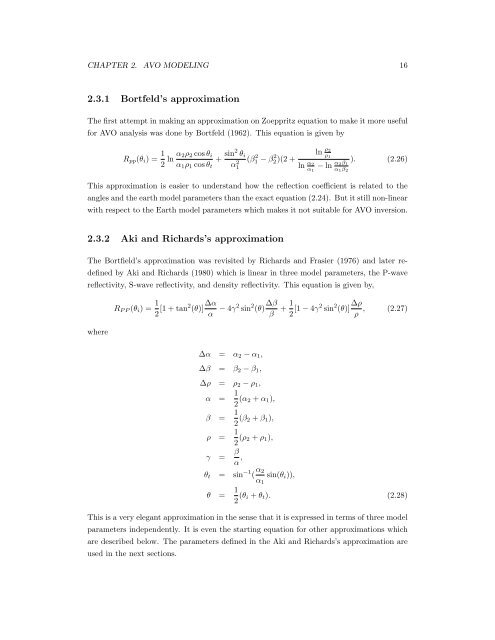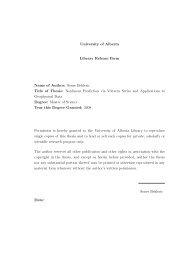Regularization of the AVO inverse problem by means of a ...
Regularization of the AVO inverse problem by means of a ...
Regularization of the AVO inverse problem by means of a ...
You also want an ePaper? Increase the reach of your titles
YUMPU automatically turns print PDFs into web optimized ePapers that Google loves.
CHAPTER 2. <strong>AVO</strong> MODELING 16<br />
2.3.1 Bortfeld’s approximation<br />
The first attempt in making an approximation on Zoeppritz equation to make it more useful<br />
for <strong>AVO</strong> analysis was done <strong>by</strong> Bortfeld (1962). This equation is given <strong>by</strong><br />
Rpp(θi) = 1<br />
2 ln α2ρ2 cos θi<br />
α1ρ1 cos θt<br />
+ sin2 θi<br />
α2 (β<br />
1<br />
2 1 − β 2 2)(2 +<br />
ln ρ2<br />
ρ1<br />
ln α2 α2β1<br />
− ln α1 α1β2<br />
). (2.26)<br />
This approximation is easier to understand how <strong>the</strong> reflection coefficient is related to <strong>the</strong><br />
angles and <strong>the</strong> earth model parameters than <strong>the</strong> exact equation (2.24). But it still non-linear<br />
with respect to <strong>the</strong> Earth model parameters which makes it not suitable for <strong>AVO</strong> inversion.<br />
2.3.2 Aki and Richards’s approximation<br />
The Bortfield’s approximation was revisited <strong>by</strong> Richards and Frasier (1976) and later re-<br />
defined <strong>by</strong> Aki and Richards (1980) which is linear in three model parameters, <strong>the</strong> P-wave<br />
reflectivity, S-wave reflectivity, and density reflectivity. This equation is given <strong>by</strong>,<br />
where<br />
RP P (θi) = 1<br />
2 [1 + tan2 (θ)] ∆α<br />
α − 4γ2 sin 2 (θ) ∆β 1<br />
+<br />
β 2 [1 − 4γ2 sin 2 (θ)] ∆ρ<br />
, (2.27)<br />
ρ<br />
∆α = α2 − α1,<br />
∆β = β2 − β1,<br />
∆ρ = ρ2 − ρ1,<br />
α = 1<br />
2 (α2 + α1),<br />
β = 1<br />
2 (β2 + β1),<br />
ρ = 1<br />
2 (ρ2 + ρ1),<br />
γ = β<br />
α ,<br />
θt = sin −1 ( α2<br />
α1<br />
sin(θi)),<br />
θ = 1<br />
2 (θi + θt). (2.28)<br />
This is a very elegant approximation in <strong>the</strong> sense that it is expressed in terms <strong>of</strong> three model<br />
parameters independently. It is even <strong>the</strong> starting equation for o<strong>the</strong>r approximations which<br />
are described below. The parameters defined in <strong>the</strong> Aki and Richards’s approximation are<br />
used in <strong>the</strong> next sections.









